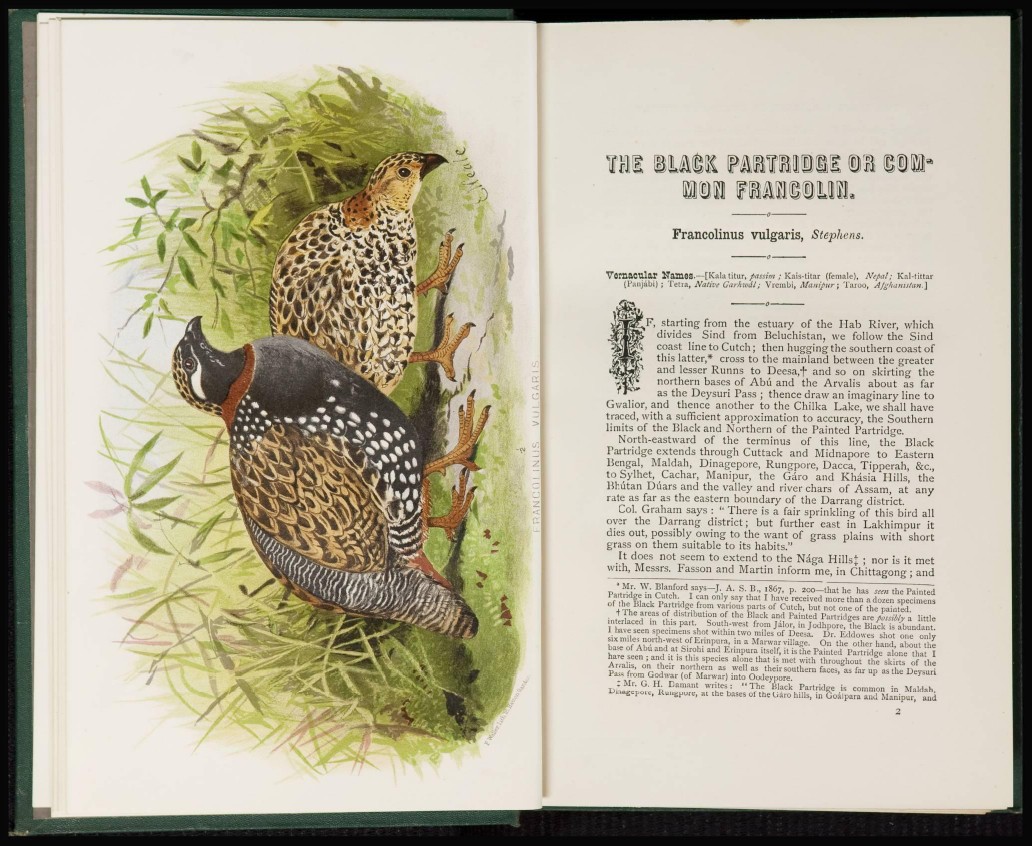
1 i S "
Francolinus vulgaris, Stephens.
0
Vernacular Names.—[Kala titur, passim ; Kais-titar (female), Nepal; Kal-tittar
(Panjabi) ; Tetia, Native Garkwil; Vrembi, Manipur; Taroo, Afghanistan]
• o
F, starting from the estuary of the Hab River, which
divides Sind from Beluchistan, we follow the Sind
coast line to Cutch; then hugging the southern coast of
this latter,* cross to the mainland between the greater
and lesser Runns to Deesa.f and so on skirting the
northern bases of Abu and the Arvalis about as far
as the Deysuri Pass ; thence draw an imaginary line to
Gwalior, and thence another to the Chilka Lake, we shall have
traced, with a sufficient approximation to accuracy, the Southern
limits of the Black and Northern of the Painted Partridge.
North-eastward of the terminus of this line, the Black
Partridge extends through Cuttack and Midnapore to Eastern
Bengal, Maldah, Dinagepore, Rungpore, Dacca, Tipperah, &c,
to Sylhet, Cachar, Manipur, the Giro and Khasia Hills, the
Bhutan Duars and the valley and river chars of Assam, at any
rate as far as the eastern boundary of the Darrang district.
Col. Graham says : " There is a fair sprinkling of this bird all
over the Darrang district; but further east in Lakhimpur it
dies out, possibly owing to the want of grass plains with short
grass on them suitable to its habits."
It does not seem to extend to the Naga Hills| ; nor is it met
with, Messrs. Fasson and Martin inform me, in Chittagong ; and
*Mr. W. Blanford says—J. A. S. B., 1867, p. 200—that he has seen the Painted
Partridge in Cutch. I can only say that I have received more than a dozen specimens
of the Black Partridge from various parts of Cutch, but not one of the painted.
t The areas of distribution of the Black and Painted Partridges are possibly a little
interlaced in this part. South-west from Jalor, in Jodhpore, the Black is abundant.
1 have seen specimens shot within two miles of Deesa. Dr. Eddowes shot one only
six mile; north-west of Erinpura, in a Marwar village. On the other hand, about the
base of Abu and at Sirohi and Erinpura itself, it is the Painted Partridge alone that I
have seen ; and it is this species alone that is met with throughout the skirts of the
Arvalis, on their northern as well as their southern faces, as far up as the Deysuri
Pass from Godwar (of Marwar) into Oodeypore.
X Mr. G. H. Damant writes: "The Black Partridge is common in Maldah,
Dinagepore, Rungpore, at the bases of the Garo hills, in Goalpara and Manipur, and